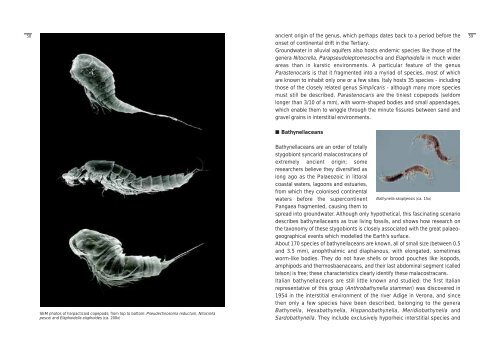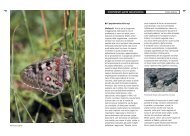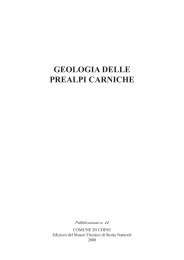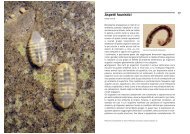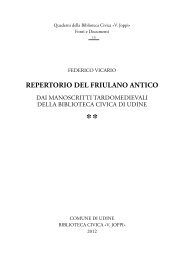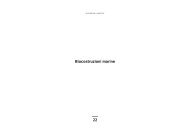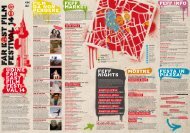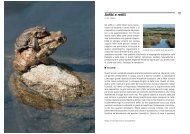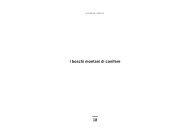Despite its inhospitable appearance and lack of any ... - Udine Cultura
Despite its inhospitable appearance and lack of any ... - Udine Cultura
Despite its inhospitable appearance and lack of any ... - Udine Cultura
You also want an ePaper? Increase the reach of your titles
YUMPU automatically turns print PDFs into web optimized ePapers that Google loves.
58<br />
SEM photos <strong>of</strong> harpacticoid copepods; from top to bottom: Pseudectinosoma reductum, Nitocrella<br />
pescei <strong>and</strong> Elaphoidella elaphoides (ca. 200x)<br />
ancient origin <strong>of</strong> the genus, which perhaps dates back to a period before the<br />
onset <strong>of</strong> continental drift in the Tertiary.<br />
Groundwater in alluvial aquifers also hosts endemic species like those <strong>of</strong> the<br />
genera Nitocrella, Parapseudoleptomesochra <strong>and</strong> Elaphoidella in much wider<br />
areas than in karstic environments. A particular feature <strong>of</strong> the genus<br />
Parastenocaris is that it fragmented into a myriad <strong>of</strong> species, most <strong>of</strong> which<br />
are known to inhabit only one or a few sites. Italy hosts 35 species - including<br />
those <strong>of</strong> the closely related genus Simplicaris - although m<strong>any</strong> more species<br />
must still be described. Parastenocaris are the tiniest copepods (seldom<br />
longer than 3/10 <strong>of</strong> a mm), with worm-shaped bodies <strong>and</strong> small appendages,<br />
which enable them to wriggle through the minute fissures between s<strong>and</strong> <strong>and</strong><br />
gravel grains in interstitial environments.<br />
■ Bathynellaceans<br />
Bathynellaceans are an order <strong>of</strong> totally<br />
stygobiont syncarid malacostracans <strong>of</strong><br />
extremely ancient origin; some<br />
researchers believe they diversified as<br />
long ago as the Palaeozoic in littoral<br />
coastal waters, lagoons <strong>and</strong> estuaries,<br />
from which they colonised continental<br />
waters before the supercontinent Bathynella skopljensis (ca. 15x)<br />
Pangaea fragmented, causing them to<br />
spread into groundwater. Although only hypothetical, this fascinating scenario<br />
describes bathynellaceans as true living fossils, <strong>and</strong> shows how research on<br />
the taxonomy <strong>of</strong> these stygobionts is closely associated with the great palaeogeographical<br />
events which modelled the Earth’s surface.<br />
About 170 species <strong>of</strong> bathynellaceans are known, all <strong>of</strong> small size (between 0.5<br />
<strong>and</strong> 3.5 mm), anophthalmic <strong>and</strong> diaphanous, with elongated, sometimes<br />
worm-like bodies. They do not have shells or brood pouches like isopods,<br />
amphipods <strong>and</strong> thermosbaenaceans, <strong>and</strong> their last abdominal segment (called<br />
telson) is free; these characteristics clearly identify these malacostracans.<br />
Italian bathynellaceans are still little known <strong>and</strong> studied: the first Italian<br />
representative <strong>of</strong> this group (Anthrobathynella stammeri) was discovered in<br />
1954 in the interstitial environment <strong>of</strong> the river Adige in Verona, <strong>and</strong> since<br />
then only a few species have been described, belonging to the genera<br />
Bathynella, Hexabathynella, Hispanobathynella, Meridiobathynella <strong>and</strong><br />
Sardobathynella. They include exclusively hyporheic interstitial species <strong>and</strong><br />
59


